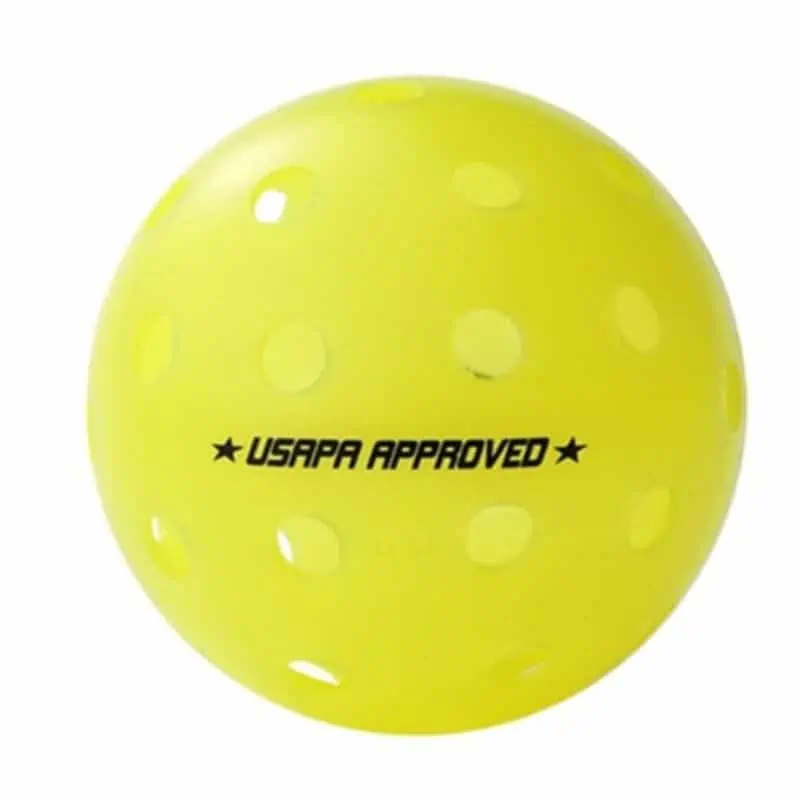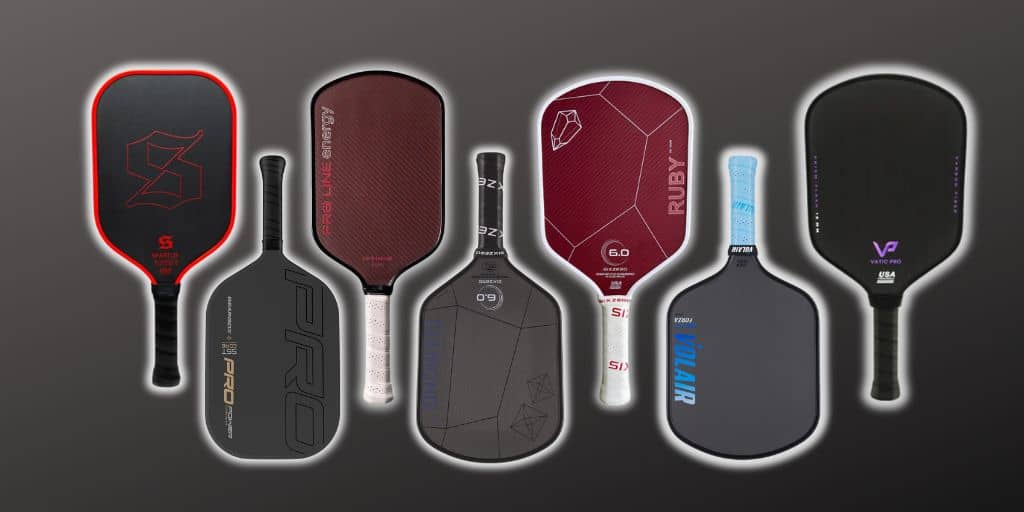Is the ball you’re using affecting your performance on the courts? Strap in, because we tested 8 of the best pickleball balls and extensively documented the difference in performance
We looked at average speed, bounce, weight, volume, and visibility so you can make the best choice based on your needs.
Comparison: Best Pickleball Balls
| Image | Features | Rating | Purchase Options |
|---|---|---|---|
| Best Tournament Ball | Franklin X-40Volume: 4 (Loud)Visibility: 2 (Good visibility)Weight: 0.93 ozSpeed: 48 mphBounce/COR: 0.626Playability: 8.8Price for 6 pack: $14.99 | 8.8 | AmazonPickleball Central |
| Most Versatile | TOP pickleballVolume: 3.5 (Slightly Loud)Visibility: 2 (Good visability)Weight: 0.92 ozSpeed: 47.2 mphBounce/COR: 0.633Playability: 8.7Price For 6 pack: $17.99 | 8.7 | AmazonPickleball Central |
| Best Beginner Ball | CORE PickleballsVolume: 2.5 (quiet)Visibility: 1 (High visibility)Weight: 0.9 ozAvg Speed: 49.4 mphBounce/COR: 0.612Playability: 8.5Price for a 6 pack: $19.99 | 8.5 | AmazonPickleball Central |
| Most Quiet Pickleball | Gamma PhotonVolume: 2 (Pretty quiet)Visibility: 3 (Decent visibility)Weight: 0.85 ozSpeed: 48.6 mphBounce/COR: 0.633Playability: 8.0Price For 6 Pack: $14.99 | 8 | Pickleball Central |
| Engage TourVolume: 4.5 (Loud)Visibility: 3 (Decent visibility)Weight: 0.9 ozSpeed: 48.1 mphBounce/COR: 0.617Playability: 7.5Price For 6 Pack: $14.99 | 7.5 | Pickleball Central | |
| Onix Dura Fast 40Volume: 3.5 (Louder)Visibility: 4.5 (Low visibility)Weight: 0.93 ozSpeed: 48.1 mphBounce/COR: 0.635Playability: 7.5 (The neon ball rates much higher – as high as a 90)Price For 6 Pack: $23.99 | 7.5 | AmazonPickleball Central | |
| Selkirk SLK CompetitionVolume: 3 (Slightly loud)Visibility: 1 (High visabilty)Weight: 0.92 ozSpeed: 48.3 mphBounce/COR: 0.614Playability: 7.5Price For 6 Pack: $15.99 | 7.5 | AmazonPickleball Central | |
| Oso 40Volume: 2.5 (Relativley Quiet)Visibility: 1 (High visibility)Weight: 0.91 ozSpeed: 47.6 mphBounce/COR: 0.636Playability: 6.5Price For 6 Pack: $19.99 | 6.5 | Pickleball Central |
Before going any further, it should be noted that we rarely play pickleball on indoor hardwood or sports court surfaces.
While we play in both indoor and outdoor facilities, most of our pickleball play occurs on tennis court or asphalt pickleball surfaces, and thus we rarely use indoor pickleball for hardwood surfaces.
A key piece of advice for beginners (as we have
often witnessed this mistake) is to make certain you are using the correct pickleball for the surface.
Indoor pickleballs tend to be slower and stickier than outdoor pickleballs because they are designed to be used on fast, slick surfaces, and thus they play incredibly differently than outdoor pickleballs.
For more check out our guide on Indoor vs. Outdoor Pickleballs
Top 8 Best Pickleball Balls – Reviews
1. Franklin Sports X-40 Outdoor Pickleballs

We have broken so many Franklin pickleballs that we were sure players would want a different ball if they drew the Franklin out of the bag. However, many players asked (begged!) to play with the Franklin after testing one of the other pickleballs.
Much of this comes from familiarity, as this is the most commonly used outdoor ball used in recreational play. The Franklin is definitely not recommended as a cold weather pickleball. The Franklin balls were one of the louder pickleballs, thus making it the source of consternation with neighbors nationwide.
Because of the combination of price, durability, and visibility, we still think the Franklin X-40 pickleball reigns supreme for the best tournament ball. As many institutions are slow to change, we don’t expect this to change for some time. However, we look for challengers in the distant future as other companies look for ways to produce brighter, more durable, or recyclable pickleballs.
Pros
- Everyone knows this ball.
- Very affordable
- Readily available
Cons
- This ball WILL crack/break eventually if playing with it under 45 degrees
2. TOP Outdoor Pickleballs

Many people don’t know this is the house-made ball for PickleballCentral. Perhaps the most surprising of all the balls we tested, the TOP was popular with players: durable, consistent, and true off the paddle.
As we moved into the mid-90 degree temperatures, the TOP pickleball played remarkably well, holding up without warping, softening, or cracking. Not one person or team returned the TOP ball to me, requesting to play with a different pickleball.
Much to our surprise, the TOP ball was incredibly versatile. The color held through weeks of play; the ball kept its consistency without breaking in cold, medium, and hot temperatures; and the ball is a fabulous value given the price point for the Pickleball Central house-manufactured ball.
Pros
- Affordable, durable, plays true
Cons
- Nobody knows about the house ball for Pickleball Central. It will be hard to convince others to try this outdoor pickleball
3. Core Pickleballs

There were minimal complaints with the Core outdoor pickleball, though it tended to play “soft and slower” as the temperatures increased.
This ball WILL NOT crack in any weather. This pickleball has become the house ball at many facilities, including Chicken N Pickle nationwide, so its durability is certainly commendable.
I have only once seen a broken Core pickleball, and it was after much abuse in local league play. The Core ball is not cheaply made, and its durability more than makes up for the higher price. From extreme heat to cold-weather play, the Core is a well-made and durable pickleball.
Pros
- Extremely Durable
Cons
- This ball plays soft after a lot of use or in extreme heat
- Relatively Expensive for Quality
4. Gamma Photon Outdoor Pickleball

The Photon was unknown to most all the players but was generally well-received in terms of durability, speed of play, and volume. If you are looking for a quiet pickleball, the Gamma Photon is the best option of the eight here.
Although this is often not your biggest concern, with the explosive growth of the sport and the construction/conversion of public courts, playing with a quiet ball might help your neighbors.
Of the eight we tested, the Gamma Photon played the quietest and tested the quietest during our bounce exercise. Additionally, the Gamma pickleball is moderately priced, kept its shape, and played very well.
Pros
- Definitely one of the quieter balls. Photon is a solid ball, deserving of more play
Cons
- It isn’t exactly cheap
5. Engage Tour Pickleball

The neon color was unavailable at the time of purchase, so we used the “yellow” ball, which is closer to orange. This coloring received some negative feedback, as did the clearly obvious seams. However, the ball played true over the course of both round robins and drilling sessions. If playing near a neighborhood, the Engage Tour is not going to win you many friends.
Pros
- The Engage Ball held up well even after considerable use. Quite durable
Cons
- The seams can be a distraction, and this ball is LOUD
6. Onix Dura Fast 40 (Yellow)
The Dura is the other pro tour pickleball of choice, although we were only able to purchase the yellow pickleballs.
The neon balls were long on back-order. The pale yellow ball occasionally caused some visibility issues, both during the daytime and under the evening lights.
This issue becomes even more troublesome after the dura has been used for some time. Still, the Dura is wildly popular, especially with the 4.5+ players, allowing for a fast-paced game, particularly in warm weather when other pickleballs get “squishy”.
The only complaint with the Dura was the visibility, which should be remedied now that the neon version is more readily available.
Pros
- Like the Franklin X-40, everyone knows the Dura Fast 40. Plus, it holds up in high heat
Cons
- Price (Pretty expensive)
- The pale yellow ball definitely has visibility issues
7. Selkirk SLK Competition Ball

The SLK was another ball that we used and enjoyed that was largely panned by the rest of the pickleball players. Players complained that it “was hard, but not responsive.”
“It sailed on me, and I couldn’t wait to finish the game and trade out pickleball.”
Pros
- Very visible
- Durable
Cons
- Complaints ranged from heavy to non-responsive to slice or spin
8. Oso 40

We REALLY wanted to love the Oso. The visibility is absolutely perfect, and it played well through the winter and spring. HOWEVER, the warmer temps made it the least favorite pickleball we used during round robin play.
It went “soft” moderately quickly and seemed to be out-of-round before any of the other pickleballs we used. Per our conversation with Oso ownership, they are working on a sturdier ball which should be available later in 2022.
The Oso pickleball was a bit quieter than the average ball.
Pros
- Highly visible
- Moderately affordable
Cons
- The Oso was the first ball to get out-of-round (oblong). Though none of them cracked, players tired of the out-of-round shape quickly
Rules and Requirements for Pickleball Balls
According to the USAPA, an official pickleball ball has to meet the following standards
- made of plastic
- Weigh between .78 to .935 ounces
- Measure 2.874 to 2.972 inches in diameter.
- The ball must be a single, consistent color.
Testing Process
Subjective data
In addition to collecting hard data, we also tested the balls in 3 different round robin play situations. Teams randomly drew the pickleballs from a bag and took them to their courts, each undergoing 9 matches over 3 hours of play. Players ranged in DUPR rating from 3.625 to 4.8, and all matches were mixed doubles so we could gather feedback from both men and women. We also rated balls on both volume and visibility, with volume = 1 is quiet/5 is loud; and visibility = 1 is highly visible/5 is hard to see.
Objective data
We tested 3 balls from each brand and tested each ball 3 times, thus culminating in 9 data points for each pickleball brand. Measurements were conducted in as controlled an environment as possible. We ran 3 tests with each ball:
- weight
- speed off the paddle
- bounce
Weight
According to the USA Pickleball Equipment Standards, “2.D.4 Weight. The ball shall weigh between 0.78 and 0.935 ounces (22.1 and 26.5 grams).” Our scale measured all 24 pickleballs within a range of 0.85 to 0.93 ounces.
Speed

Using the radar gun (purchased exclusively for the purpose of this testing) placed at the net and measuring a forehand drive from the baseline from a single player, we picked up speeds ranging from 43 mph to 54 mph. It should be noted that speeds generally increased as the test progressed, as my forehand drive loosened and opened up. As such, there is inherent error in this measurement that is independent of the ball.

Bounce
This was the most scientific of our tests, stretching our understanding of physics. We gently rolled the pickleball off a steel I-beam onto a flat concrete surface exactly 2.273 meters (89.5”) high.

This was a controlled environment with no wind effect, no variability in height or bounce surface, and minimal rotation. Using a studio condenser microphone, we captured the precise time between the first and second bounce (to hundredths of a second [e.g., 0.85 seconds]), and using Newton’s experimental law, calculated the height of the bounce.
We then calculated the coefficient of restitution (COR), which is a number between 0 and 1 that measures the “bounciness” of the ball and the surface in the collision.
The COR is defined as the speed of the ball immediately after bouncing off the surface divided by the speed immediately before bouncing off the surface. Examples of CORs are 0.60 for a steel bearing ball, 0.74 for a tennis ball, and 0.86 for a golf ball.

According to the USA Pickleball Association, the COR should be between 0.66-0.68 when dropped on a granite plate from a height of 78”. As noted, we dropped our pickleballs from a little higher and onto a concrete slab, which absorbs more energy and is slightly rougher than granite. Our average CORs were between 0.612 and 0.636 – slightly below USAPA requirements, but they were tested within their own standardized environment, making cross-ball comparisons valid.
What Is The Best Ball in pickleball?
The best pickleball is the Franklin x-40. The combination of durability, visibility, and price make it the go-to ball for casual and tournament play.
However, it really depends on what you’re looking for in a ball. If you need a quiet pickleball, the game photon is your best bet. Those looking for more visibility should consider the Oso 40 or the SLK competition.
We made this review because we know that selecting pickleball equipment is not a one-size fit all. Different players have different needs. Our top priority is to make sure you have more fun and enjoy the game.





